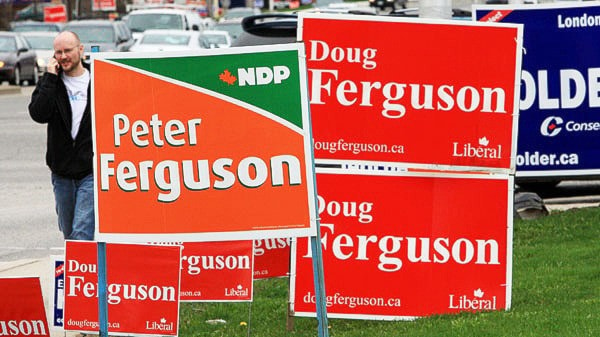Spring seems finally to have sprung, several weeks after its official arrival, and not a moment too soon for many people. Judging by the piles of garden detritus in front of people’s homes, gardeners have been busy pruning, chopping, and thinning, getting their yards and gardens ready for another year.
Bulbs are sprouting; birds are nesting; the hillsides are turning a welcome green after months of brown; trees are in bud; and it can’t be long before the sound of the lawnmower is heard throughout the land. But bulbs aren’t the only things sprouting. In a sure sign that a spring election is at hand, campaign signs have started bursting forth on local roadsides. They add a welcome touch of colour, to be sure; but can they go too far?
At least one municipality in British Columbia has said “Hell, yes,” and taken steps to limit the number of campaign signs that candidates can put up on public land. The City of Quesnel has enacted a bylaw which states that a candidate can put up no more than six campaign signs on public land throughout the city. That’s not six signs per piece of public land; that’s six signs, period, throughout the entire city (a resident may put up as many campaign signs as she wants on her private property).
Judging by what I saw in Kamloops during the last round of municipal elections, in November 2014, this decision is a Good Thing for the residents of Quesnel. I remember driving up Notre Dame to the junction with Hillside and being confronted with a solid bank of signs—more than a dozen—for a single candidate, and this was not the only example I saw. Distracting? Yes. Annoying? Certainly. Effective? If enough voters get distracted and/or annoyed, probably not.
There are two schools of thought about campaign signs. One is that campaign signs are a vital tool of politicians, helping to promote their name recognition and indicate broad support (the equation seems to be the more lawn signs out there, the more support you have).
The other school of thought is that campaign signs can quickly become the visual equivalent of white noise; something that passers-by tune out, and which are therefore a waste of money when a dozen or more for the same candidate are on a single piece of land.
Quesnel Mayor Bob Simpson says that it “became the question of why do politicians get access to public space for unfettered use. What a lot of our community members say is it pollutes public space with their signs, during an election period.”
Former cabinet minister Pat Bell feels that more than six signs should be allowed on public property, but is otherwise in agreement with Quesnel’s decision. “I always loved the idea of having signs on private property because I think that’s a real testament to people that are going to vote for you,” he says. “Signs on public property are irrelevant from my perspective. You look at them and they really clutter up the environment.”
We can all expect more campaign signs to sprout up in the next few weeks. Are they news, novelty, (white) noise, or nuisance? One thing we know for sure: come May 10, they’ll be gone for another four years.
